Prominent African Americans
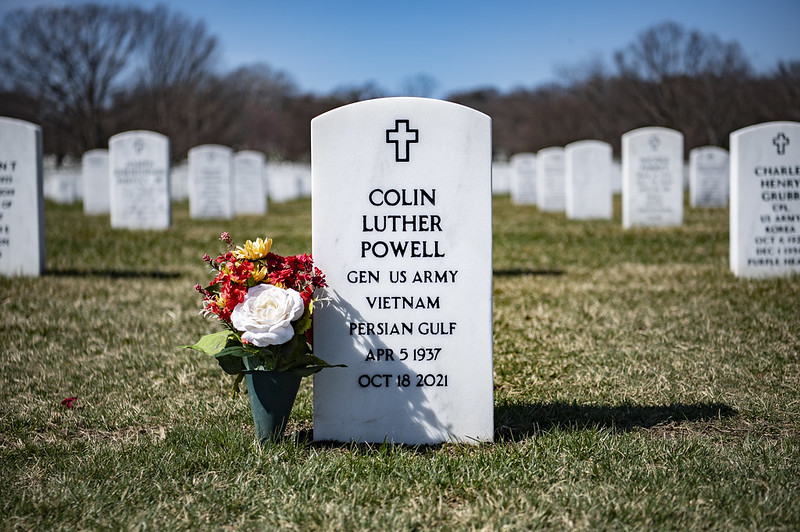
► For more about African American history at Arlington National Cemetery, explore our Education Program resources—including walking tours, readings, lesson plans and learning materials for students from elementary through high school.
Lee "Buddy" Archer, U.S. Air Force (1919–2010) — When Lee "Buddy" Archer enlisted in the U.S. Army in 1941, he wanted to become an aviator, but was initially rejected from pilot training on account of his race. A year later, however, he received acceptance to a new training program for Black pilots at the Tuskegee Army Airfield in Alabama. Graduating first in his class, he became one of the Tuskegee Airmen, assigned to the 302nd Fighter Squadron of the 332nd Fighter Group. During World War II, Archer flew 169 combat missions across 11 nations and earned the Distinguished Flying Cross. His most famed aerial combat mission occurred on October 12, 1944, when he shot down three German planes in ten minutes. Archer transitioned to the Air Force after its creation as a separate service branch in 1947, retiring in 1970 as a lieutenant colonel. (Section 6, Grave 9215 RH)
Alexander T. Augusta, U.S. Army (1825–1890) — Augusta was the U.S. Army's first African American physician, as well as the United States' first African American hospital administrator (Freedman's Hospital, Washington, D.C.) and professor of medicine (Howard University). A graduate of Canada's Trinity Medical College, he was commissioned as a major during the Civil War, serving as regimental surgeon of the 7th Infantry of the U.S. Colored Troops. Promoted to brevet lieutenant colonel in 1865, Augusta became the highest-ranking African American officer of the Civil War. He went on to become one of the founding faculty members of the nearly all-white Howard University Medical Department. (Section 1, Grave 124-C)
"Buffalo Soldiers" — In 1866, after the United States Colored Troops (see below) were disbanded, Congress established six all-Black Army regiments, to be stationed on the western frontier. American Indians, whom these soldiers battled from the 1860s through 1890s, likely gave them the nickname "Buffalo Soldiers" either because their dark curly hair resembled a buffalo's mane, or because the soldiers fought as fiercely as Great Plains buffalo. The soldiers embraced their nickname and, during World War I, the 92nd Infantry adopted the buffalo as the symbol for its shoulder patch. During nearly 30 years of service on the American frontier, the Buffalo Soldiers participated in nearly 200 engagements, and 14 of them were awarded the Medal of Honor. These regiments continued to distinguish themselves in battle during the Spanish-American War (1898) and the Philippine-American War (1899-1902), participating alongside Teddy Roosevelt's Rough Riders in the famed Battle of San Juan Hill. In 1951, three years after desegregation of the armed forces, the Army disbanded the last of the original Buffalo Soldier regiments. Several of these service members are buried at Arlington, including Cpl. Isaiah Mays (Section 1, Grave 630-B), Master Sgt. George H. Wanton (Section 4, Grave 2749) and Col. Charles Young (Section 3, Grave 1730-B). A memorial plaque in Section 35, a few feet away from the Rough Riders Monument, honors the service of all Buffalo Soldiers.
Roscoe Conklin “Rock” Cartwright, U.S. Army (1919–1974) — The first Black graduate of any Army Officer Candidate School to be promoted to brigadier general, Cartwright was drafted into the Army in 1941. He attended Fort Sill Officer Candidate School and was commissioned as a second lieutenant in 1942. During World War II, he led the 599th Field Artillery Battalion, 92nd Infantry Division—the famed “Buffalo Soldiers”—through combat in Italy. He subsequently served combat tours in Korea and Vietnam. On August 1, 1971, Cartwright became the U.S. Army’s third Black brigadier general. Yet one of his most enduring contributions to the Army occurred off the battlefield. Cartwright founded a social group that provided mentoring and leadership training to African American officers; prominent members included Generals Colin Powell (Section 60) and Roscoe Robinson Jr. (Section 7A). Cartwright retired from the Army in 1974 after over 33 years of service. In December of that year, he and his wife, Gloria, were tragically killed in a plane crash. In Cartwright’s honor, the group he had founded was named “THE ROCKS”; to this day, they continue to mentor officers. Brig. Gen. Cartwright’s many awards include the Legion of Merit, the Bronze Star and the Army Commendation Medal. (Section 5, Grave 140)
Cornelius H. Charlton, U.S. Army (1929–1951) — Charlton joined the U.S. Army after graduating from high school in 1946, and served in the Korean War as a member of the 24th Regiment — the last all-Black combat unit in the Army. He received the Medal of Honor for heroism in action on June 2, 1951. After his commanding officer was wounded and evacuated, Sgt. Charlton took command of his platoon and led his men, under heavy fire, to take a strategic position on a hill near Chipo-ri. Despite a severe chest wound, Charlton charged an enemy encampment alone, destroying it before dying of his wounds. (Section 40, Grave 300)
"Contrabands" — An estimated 3,000 Civil War-era "contrabands" — enslaved people who escaped to freedom — are buried in Section 27 of the cemetery. "Contraband" is the term for confiscated enemy property. Because enslaved people were legally considered property, "contraband" was the U.S. government's designation for those who were freed as Union forces moved south during the war, or who had escaped from local Virginia and Maryland slave owners. Their headstones are marked "Citizen" or "Civilian."
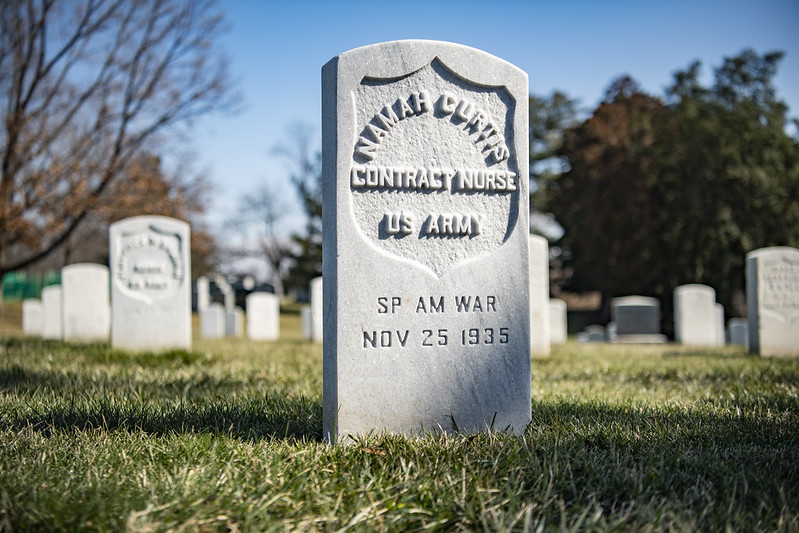
Namahoyke "Namah" Curtis, U.S. Army (1861–1935) — Namahyoke Curtis, known as Namah, was a prominent African American nurse in late-19th-century Washington, D.C. During the Spanish-American War (1898), the Surgeon General assigned her to recruit other Black women to serve as U.S. Army contract nurses. She recruited as many as 32 Black nurses for the war effort. Curtis was of African American, European and American Indian descent, and she married Dr. Austin Curtis, a leading Black physician and the superintendent of Freedmen’s Hospital in D.C. She is buried in the “Nurses' Section,” which contains the gravesites of many military nurses and the Spanish-American War Nurses Memorial. (Section 21, Grave 15999-A-1)
Benjamin O. Davis Sr., U.S. Army (1877–1970) — The first African American general in the U.S. military, Benjamin O. Davis volunteered in the Spanish-American War (1898) and then enlisted as a private in the U.S. Army's 9th Cavalry Regiment. He served in the Philippines during the Philippine-American War in 1901-1902, and then as a military attache in Liberia — postings which ensured that Davis would not command white troops. He also taught military science at Wilberforce University and Tuskegee Institute, both historically Black universities. Meanwhile, Davis rose through the ranks to become a lieutenant colonel in 1920 and a colonel in 1930, and President Franklin D. Roosevelt promoted him to brigadier general in 1940. During World War II, as an assistant to the Army's Office of the Inspector General, Brig. Gen. Davis advised the U.S. government on race relations within the military. His awards include the Distinguished Service Medal and the Bronze Star. (Section 2, Grave E-478-B)
Benjamin O. Davis Jr., U.S. Air Force (1912–2002) — The son of Brig. Gen. Benjamin O. Davis Sr., Benjamin O. Davis Jr. was the first African American general in the U.S. Air Force. A 1936 graduate of West Point, he was among the first group of African Americans admitted to the U.S. Army Air Corps. During World War II, he commanded the 99th Pursuit Squadron — the first all-Black American air unit, which flew tactical support missions in the Mediterranean theater — and the 332nd Fighter Group, more famously known as the Tuskegee Airmen. After President Harry S. Truman desegregated the armed forces by executive order in July 1948, Davis helped draft a plan to implement the order. Davis commanded a fighter wing in the Korean War and was promoted to brigadier general in 1954. During the 1950s and 1960s, he held major Air Force command posts in Asia, Europe and the United States. Advanced to four-star rank in 1998, Gen. Davis' military decorations include the Air Force Distinguished Service Medal, the Army Distinguished Service Medal, the Silver Star, the Legion of Merit, the Distinguished Flying Cross and the Air Medal. (Section 2, Grave E-311-RH)
James Reese Europe, U.S. Army (1881–1919) — Fellow jazz great Eubie Blake called James Reese Europe "the Martin Luther King of music." The renowned bandleader and musician first studied violin as a child with the assistant director of the Marine Corps Band. By his twenties, Europe had become an acclaimed musician, performing at Carnegie Hall with the Clef Club, the all-Black orchestra he founded in 1910. When the United States entered World War I in 1917, Europe enlisted and was commissioned as a lieutenant with the 369th Infantry, the "Harlem Hellfighters." Europe was ordered to form a military band of the best musicians he could muster. Known as the Hell Fighters Band, the ensemble performed across continental Europe to great enthusiasm and praise. Europe credited the band's success to the fact that the musicians played only their own, original music — Black music. Tragically, Reese lost his life during a dispute with another band member in 1919. (Section 2, Grave 3576)
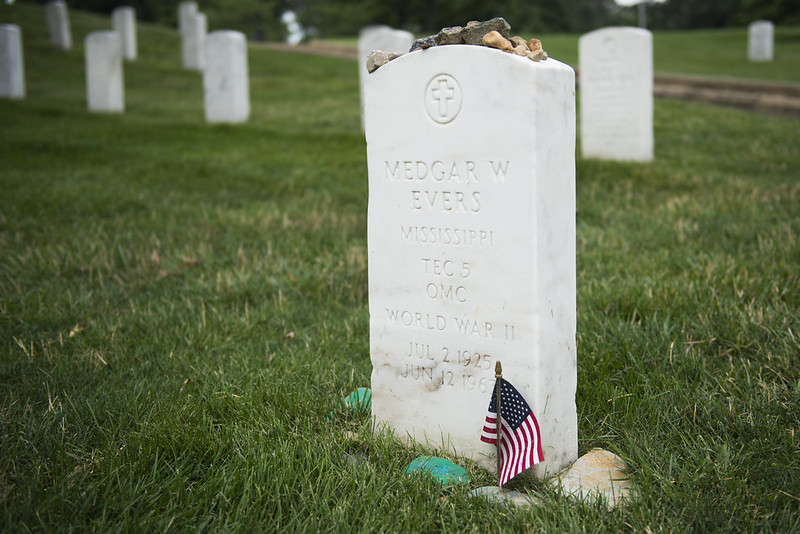 Medgar Evers, U.S. Army (1925–1963) — Born in Decatur, Mississippi, Sgt. Medgar Evers served in the U.S. Army during World War II, fighting with a segregated unit in France and Germany. His experiences of racial discrimination, both in and out of uniform, motivated him to become a civil rights activist. As Mississippi field secretary of the National Association for the Advancement of Colored People (NAACP), Evers recruited hundreds of members, organized voter registration drives and economic boycotts, and investigated racially based crimes, including the 1955 lynching and murder of Emmett Till. In response, white supremacists repeatedly threatened his life. On June 12, 1963, a Ku Klux Klan member shot and killed Evers in front of his home. The murder made national headlines, and thousands of mourners attended Evers' full military honors funeral at Arlington. The following year, President Lyndon B. Johnson signed the Civil Rights Act of 1964 — one victory in the struggle for which Evers sacrificed his life. (Section 36, Grave 1431)
Medgar Evers, U.S. Army (1925–1963) — Born in Decatur, Mississippi, Sgt. Medgar Evers served in the U.S. Army during World War II, fighting with a segregated unit in France and Germany. His experiences of racial discrimination, both in and out of uniform, motivated him to become a civil rights activist. As Mississippi field secretary of the National Association for the Advancement of Colored People (NAACP), Evers recruited hundreds of members, organized voter registration drives and economic boycotts, and investigated racially based crimes, including the 1955 lynching and murder of Emmett Till. In response, white supremacists repeatedly threatened his life. On June 12, 1963, a Ku Klux Klan member shot and killed Evers in front of his home. The murder made national headlines, and thousands of mourners attended Evers' full military honors funeral at Arlington. The following year, President Lyndon B. Johnson signed the Civil Rights Act of 1964 — one victory in the struggle for which Evers sacrificed his life. (Section 36, Grave 1431)
Samuel Lee Gravely Jr., U.S. Navy (1922–2004) — The first African American to rise to the rank of vice admiral, the first to command a warship and the first to command a U.S. fleet, Vice Adm. Samuel Lee Gravely Jr. served in the Navy for nearly 40 years, from 1942 to 1980. During World War II, he was the only African American officer on the USS PC-1264, a submarine chaser with a predominately Black crew. During the Vietnam War, when he took command of the destroyer escort USS Falgout, he became the first African American officer to command a combat ship. From 1976 to 1978, he commanded the Hawaii-based Third Fleet, and then directed the Defense Information Systems Agency (DISA) until his retirement. (Section 66, Grave 7417)
Marcelite Jordan Harris, U.S. Air Force (1943–2018) — Maj. Gen. Marcelite Jordan Harris retired in 1997 as the highest-ranking female officer in the U.S. Air Force and the highest ranking African American woman in the Department of Defense. A graduate of Spelman Academy, she was commissioned as an officer in 1965, rising through the ranks to become, in 1991, the first African American female brigadier general in the Air Force. Many of her assignments represented "firsts" for women in the Air Force. Her medals included the Bronze Star and the Legion of Merit. (Section 30, Grave 621-RH)
Allie G. Harshaw, U.S. Air Force (1918–2013) — Allie Harshaw served with the renowned Tuskegee Airmen and the 6888th Central Postal Directory Battalion, the only Black Women's Army Corps (WAC) unit to serve overseas during World War II. She graduated from the Tuskegee Institute, a historically Black university, in 1940, and later earned a Ph.D. in Human Behavior from the United States International University at San Diego, California. In 1943, she enlisted in the Women’s Auxiliary Army Corps (WAAC) and served as a physical therapy technician with the Tuskegee Airmen, the first African American flying unit in the U.S. military. She then served in the "Six Triple Eight." Harshaw transferred to the U.S. Air Force after its creation in 1947 and served through the Korean and Vietnam Wars, retiring in 1973. Harshaw was the first Black female Air Force master sergeant to retire with thirty years of military service. In 2007, she received the Congressional Gold Medal for her service with the Tuskegee Airmen. (Section 64, Grave 5494)
Milton Holland, U.S. Army (1844–1910) — Born into slavery, Milton Holland enlisted in the 5th United States Colored Infantry regiment in 1863, rising to the rank of sergeant major. During the Battle of New Market Heights and Chaffin's Farm on September 29, 1864, Holland assumed command of the regiment after all of its white commanding officers were killed or wounded. He gallantly led his men as they routed the attacking Confederate Army and regained control of strategic territory near Richmond, Virginia. Holland received a Medal of Honor for his actions in the battle. He later founded the first Black-owned insurance company in Washington, D.C. (Section 23, Grave 21713)
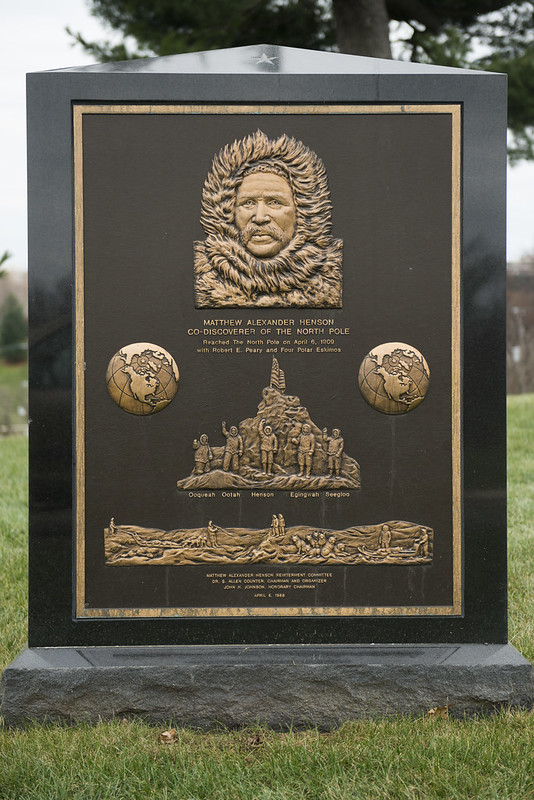
Matthew A. Henson (1886–1955) — With Robert E. Peary, the African American explorer Matthew Henson discovered the North Pole on April 6, 1909. Born to sharecropper parents in Maryland, he was orphaned at a young age and spent six years at sea as a cabin boy. While working as a shop clerk in Washington, D.C., he met Peary, who hired him as an assistant on an expedition to Nicaragua. Between 1891 and 1909, Henson and Peary conducted seven Arctic expeditions, chronicled in Henson's 1912 book, "A Negro Explorer at the North Pole." For much of his life, racism prevented Henson from receiving the public recognition accorded to Peary. Originally buried at New York's Woodlawn Cemetery, in 1988 he was reinterred at Arlington next to Peary, in a long-overdue honor. (Section 8, Grave S-15-1)
Daniel "Chappie" James Jr., U.S. Air Force (1920–1978) — The first African American four-star officer in the armed forces, Gen. Daniel "Chappie" James Jr. was a decorated fighter pilot who earned his Army Air Corps wings in 1943 at Tuskegee Army Airfield, where he trained pilots for the all-Black 99th Pursuit Squadron during World War II. He flew 101 combat missions in Korea and 78 combat missions in Vietnam — including a flight in "Operation Bolo" on January 2, 1967, which destroyed seven Communist MiGs, the highest total kill of any mission during the Vietnam War. James was promoted to the four-star rank of general in 1975, and assigned as commander-in-chief of NORAD/ADCOM at Peterson Air Force Base in Colorado. At age 58, he died from a heart attack, just three weeks after his retirement from the Air Force. (Section 2, Grave 4968)
Henry Johnson, U.S. Army (1892–1929) — During World War I, Sgt. Henry Johnson served in France with the U.S. Army's 369th Infantry Regiment, an African American unit nicknamed the "Harlem Hellfighters." He was the first American soldier to earn France's highest military honor, the Croix de Guerre, for his actions in combat in the Argonne Forest. In the early morning hours of May 15, 1918, Johnson and Pvt. Neadom Roberts were on sentry duty when a squad of Germans began firing at them. Both were severely wounded, and Johnson continued fighting even after taking bullets in the arm, head and side, and suffering 21 wounds in hand-to-hand combat. He was posthumously awarded the Medal of Honor, the Purple Heart and the Distinguished Service Cross. (Section 25, Grave 64)
Hazel W. Johnson-Brown, U.S. Army (1927–2011) — The first African American woman to attain a general officer rank in American military history, Brig. Gen. Johnson-Brown was appointed in 1979 as chief of the Army Nurse Corps with the rank of brigadier general. She joined the Army Nurse Corps in 1955, in which she served until her retirement in 1983. In 1976, she was named the director and assistant dean of the Walter Reed Army Institute of Nursing. (Section 60, Grave 9836)
Louia Vaughn Jones, U.S. Army (1895–1965) — Sgt. Louia Vaughn Jones was an internationally renowned violinist and professor of music at Howard University. A graduate of the New England Conservatory of Music, he served in France during World War I as the assistant bandleader of the U.S. Army's 807th Pioneer Infantry band. Jones returned to France after the war and performed throughout Europe during the 1920s, including a command performance for the king and queen of Spain. In 1930, he accepted a position as head of the violin department at Howard, where he taught for the next 30 years. In 1935, Jones became the first African American to perform with the National Symphony Orchestra, although the concert took place at Howard due to Constitution Hall's discriminatory booking policies. (Section 43, Grave 511)
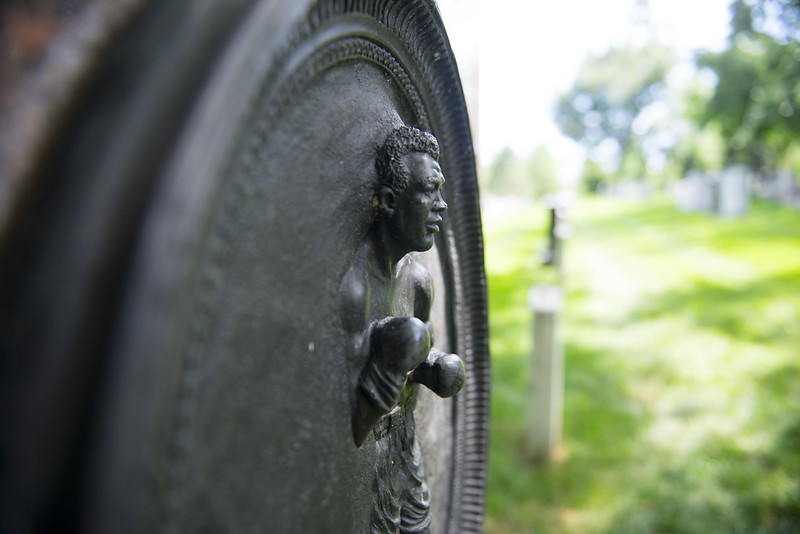
Joe Louis (Barrow), U.S. Army (1914–1981) — Joe Louis Barrow, "The Brown Bomber," held the title of Heavyweight Champion of the World for longer, and defended it more times, than any other boxer in history. In 1942, he donated the purses from two fights, totaling nearly $100,000, to Army and Navy relief societies. After enlisting in the Army later that year, he fought 96 exhibition matches for more than two million troops. In 1945, Sgt. Louis was awarded the Legion of Merit for his contributions to troop morale during the war. (Section 7A, Grave 177)
Ruth Lucas, U.S. Air Force (1920–2013) — During World War II, Ruth Lucas enlisted in the Women’s Army Auxiliary Corps (WAAC) and became one of the few Black women to attend what is now the Joint Forces Staff College in Norfolk, Virginia. She transferred from the Army to the Air Force in 1947, where she stayed for the remainder of her military career. While stationed in Tokyo, Japan as chief of the Air Force Awards Division (1951-1954), she spent much of her free time teaching English to Japanese students. Upon returning to the United States, she earned a graduate degree in educational psychology from Columbia University. She was then transferred to Washington, D.C. to develop educational programs for service members. In 1968, she became the first Black woman promoted to colonel in the Air Force. She also received the Defense Meritorious Service Medal, awarded for outstanding non-combat service. (Section 64, Grave 6031)
Thurgood Marshall (1908–1993) — Appointed by President Lyndon B. Johnson in 1967, Thurgood Marshall was the first African American Supreme Court justice, and the only African American justice during his 24-year tenure. A graduate of Howard University Law School, Marshall founded the NAACP Legal Defense and Educational Fund. He won 29 out of 32 cases that he argued before the Supreme Court — including Brown v. Board of Education (1954), which held that the racial segregation of public schools violated the Constitution. As a Supreme Court justice, Marshall continued advocating for the civil rights of African Americans and other minorities. He described his legal philosophy as, "You do what you think is right, and the law will catch up." (Section 5, Grave 40-3)
Isaiah Mays, U.S. Army (1858–1925) — Isaiah Mays was one of 18 African American soldiers to earn the Medal of Honor for their service as "Buffalo Soldiers" during the so-called "Indian Wars" of the late 19th century. Mays, who was born into slavery, became a corporal in Company B of the 24th Infantry Regiment, stationed in the Arizona Territory. He received the Medal of Honor for heroic action during the so-called "Wham Paymaster Robbery" of 1889, in which Mays fought bandits who had robbed the Army paymaster. After decades in an unremarkable Arizona grave, Mays' remains were reinterred at Arlington National Cemetery in 2009. (Section 1, Grave 630-B)
James Parks, U.S. Army (1843–1929) — Born into slavery on the Custis plantation, James Parks lived on the Arlington estate for nearly 90 years. He gained his freedom in 1862, under the terms of the will left by George Washington Parke Custis. At Arlington, Parks worked for the U.S. Army from 1861 to 1929, digging graves, maintaining cemetery grounds and helping to build forts. He died in 1929, leaving behind 22 children and a rich oral history. Parks is the only person buried at Arlington National Cemetery who was born on the property. (Section 15E, Grave 2)
Lemuel A. Penn, U.S. Army (1915–1964) — An educator and World War II veteran, Penn joined the Army Reserve as a student at Howard University. During World War II, he served in New Guinea and the Philippines, attaining the rank of lieutenant colonel and earning a Bronze Star. After the war, he worked in education, becoming assistant superintendent of the Washington, D.C. public schools. On July 11, 1964, Lt. Col. Penn and two other veterans were returning from reserve training at Fort Benning, Georgia when local Ku Klux Klansmen began shooting at their car, killing Penn. After a local jury failed to convict the suspects of murder, the federal government prosecuted them for violating the Civil Rights Act of 1964, passed just nine days before Penn's murder. (Section 3, Grave 1377-LH)
Frank E. Petersen Jr., U.S. Marine Corps (1932–2015) — The son of a sugar cane plantation worker, Petersen decided to join the military after Pearl Harbor. He enlisted in the Navy in 1950 and, after completing flight training, accepted a commission as a second lieutenant in the Marine Corps. The first African American aviator in the Marines, Petersen flew more than 350 combat missions during the Korean and Vietnam Wars, earning a Distinguished Service Medal, a Distinguished Flying Cross, and a Legion of Merit. Later, he became the first African American Marine to command a fighter squadron, an air group and a major base. He retired from the Marine Corps in 1988 as a three-star lieutenant general — and, in yet another "first," the first African American Marine Corps general. (Section 33, Grave 4571)
Spottswood Poles, U.S. Army (1887–1962) — One of the best Negro League baseball players of the early 20th century, Spottswood "Spot" Poles has been called the "Black Ty Cobb." Playing for the New York Lincoln Giants, he achieved a batting average of .487 during the 1914 season. In 1917, he enlisted in the U.S. Army's 369th Infantry Regiment — a primarily African American unit attached to the French army, also known as the "Harlem Rattlers" (their insignia featured a silver rattlensnake). Serving in France during World War I, Sgt. Poles earned five battle stars and a Purple Heart. (Section 42, Grave 2324)
Colin L. Powell, U.S. Army (1937–2021) — General Colin Powell, a Vietnam veteran, was the first African American to hold three of the U.S. government’s highest positions: national security advisor (1987-1989), chairman of the Joint Chiefs of Staff (1989-1993), and secretary of state (2001-2005). The son of Jamaican immigrants, Powell grew up in the South Bronx and enrolled in Army ROTC during college; he was commissioned as a second lieutenant in 1958. By 1989, he had risen to the rank of four-star general. His many awards and decorations include two Presidential Medals of Freedom and the Congressional Gold Medal. (Section 60, Grave 11917)
Mary Crawford Ragland, U.S. Army (1922–2010) — Ragland served in the 6888th Central Postal Directory Battalion, the only all-Black, all-female Women’s Army Corps (WAC) unit to serve overseas during World War II. Raised in Wilmington, Delaware, she enlisted in the U.S. Army right out of high school. After basic training, she sailed with her unit to England, arriving in Birmingham in March 1945. Ragland worked as a clerk for the 6888th, whose mission was to clear a two-year backlog of mail sent to U.S. service members fighting in Europe. She helped the unit complete its mission, which was expected to take six months, in only three months. When the war in Europe ended in May 1945, she traveled with her unit to Rouen, France, where they processed another two-year backlog of mail in three months. She later said of her service, “We represented our country, our organization and ourselves. We were so proud.” (Columbarium Court 7, Section PP, Column 2, Niche 5)
Roscoe Robinson Jr., U.S. Army (1928–1993) — In 1982, Gen. Robinson became the first African American in the Army to attain four-star rank, and the second in the military (after Daniel "Chappie" James of the U.S. Air Force). In a 34-year military career that began in 1951, the West Point graduate served with the 7th Infantry Division during the Korean War and the 1st Cavalry Division in Vietnam. He earned two Silver Stars, three Legions of Merit, the Distinguished Flying Cross and a Bronze Star. Gen. Robinson served as U.S. representative to the North Atlantic Treaty Organization (NATO) for the three years preceding his retirement in 1985. (Section 7A, Grave 18)
6888th Central Postal Directory Battalion (Women's Army Corps) — The U.S. Army’s 6888th Central Postal Directory Battalion was the only all-Black, all-female Women’s Army Corps (WAC) unit to serve overseas during World War II. The primary mission of the “Six Triple Eight,” as the unit was popularly known, was to sort the two- to three-year backlog of undelivered mail for U.S. service members in England and France. The unit, organized on March 4, 1945 in Birmingham, England, contained about 850 officers and enlisted personnel who formed four companies. Whereas most Black units in the military contained white officers, every position in the 6888th was staffed by Black women. The Army initially gave the 6888th six months to clear several warehouses filled with returned mail and packages. By working around the clock in three eight-hour shifts, including on weekends, the women accomplished their mission in only three months. When they completed their mission, the women of the 6888th had broken all records for redirecting mail, sorting an average of 5.85 million parcels per month. Through their dedicated service in the face of discrimination, members of the Six Triple Eight successfully challenged barriers of both race and gender. In 2022, the unit received the Congressional Gold Medal. Click here for more information, and a list of members of the 6888th who are buried at ANC.
Frank Snowden, U.S. Army (1885–1977) — During World War II, Snowden was the senior African American officer at Camp Lee, Virginia, where he advised the Army on race relations. He subsequently held several civilian positions in the Army. His son, Frank Snowden Jr., was a pre-eminent scholar of classics and recipient of the National Humanities Medal. (Section 12, Grave 8471-3)
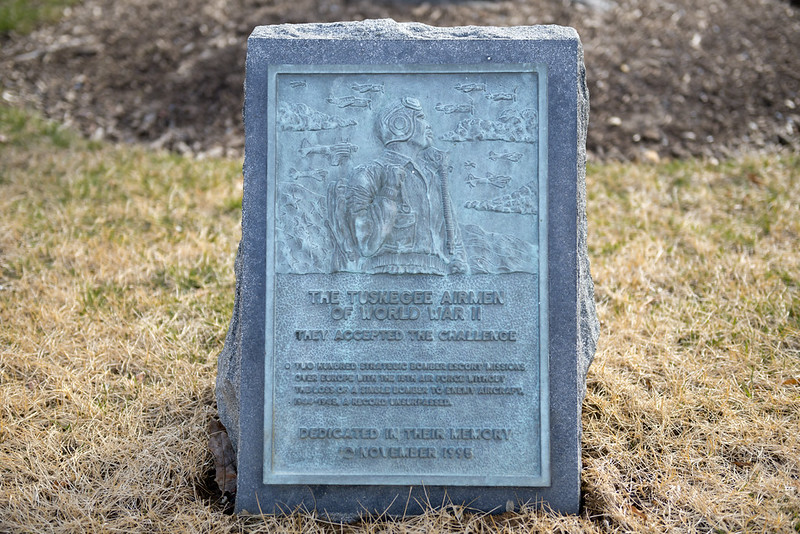
Tuskegee Airmen — In spite of the accomplishments of numerous Black civilian aviators during the early 20th century, prior to World War II the U.S. military did not permit African Americans to become aviators. However, in response to a pilot shortage in the United States as well as pressure from civil rights groups, in June 1941 the U.S. Army Air Corps launched an experimental training program for African American aviators, located at Tuskegee Army Airfield near Tuskegee Institute, a historically Black university in Alabama. Between 1941 and 1946, 966 African American men completed military pilot training at Tuskegee. Comprising the 332nd Fighter Group and the 477th Composite Group of the U.S. Army Air Forces, the "Tuskegee Airmen" completed more than 1,800 missions during World War II. A memorial tree and plaque stand in Section 46 of the cemetery. See the list of Tuskegee Airmen buried at Arlington National Cemetery.
United States Colored Troops (USCT) — During the Civil War, the U.S. government recruited African Americans to serve in all-Black regiments of the Union Army, collectively called the United States Colored Troops (USCT). More than 178,000 African Americans served in USCT units, comprising 15 percent of the Union's total land force. Seventy-four percent of Northern Black men of age served; approximately 140,000 men were recruited from slave states. The USCT units suffered heavy casualties, with 2,751 killed in combat and more than 65,000 missing or killed by disease. Black soldiers also risked death or severe punishment if they were captured by the Confederacy. Buried in Section 23 and Section 27, their headstones are marked with a Civil War shield and the letters "U.S.C.T." or "U.S.C.I." (U.S. Colored Infantry).
USS Maine Sailors — The sinking of the USS Maine in Havana Harbor, Cuba on February 15, 1898 prompted the United States to declare war against Spain, beginning the Spanish-American War. More than 260 crew members lost their lives in the incident, including 22 African American sailors. They are buried in Section 24, near a large memorial that features the ship's mast.
O.S.B. Wall, U.S. Army (1825–1891) — Orindatus Simon Bolivar Wall was the mixed-race son of a white plantation owner and an enslaved woman. During the Civil War, he was commissioned as a captain in the U.S. Army, one of the first African Americans to achieve that rank — and one of approximately 100 African American officers during the Civil War. After the war, he received a law degree from Howard University, became Washington D.C.'s first African American justice of the peace and was elected twice to the city's legislative assembly, representing a white district. (Section 1, Grave 124-B)
Charles Young, U.S. Army (1864–1922) — Charles Young was born into slavery in 1864 in Kentucky. His father, Gabriel Young, escaped and joined the U.S. Colored Troops during the Civil War. In 1889, Young became the third African American to graduate from West Point. He served in the Philippine-American War (1899-1902) and subsequently became the first African American superintendent of a national park (1903) and the first African American to attain the rank of colonel (1917). Young died in 1922, while serving as a U.S. military attache in Liberia. He was honored with a full military honors memorial service at Arlington. Attended by some 5,000 people, it was the fourth service to be held in the newly constructed Memorial Amphitheater. (Section 3, Grave 1730-B)
See also:
• Freedman's Village: Even before Arlington became a military cemetery, part of the land housed a community for formerly enslaved people. The story of Freedman's Village connects Arlington National Cemetery to the national history of slavery and emancipation.
• Section 27: One of the oldest sections of the cemetery, Section 27 contains the gravesites of thousands of African Americans, including freedpeople and members of the United States Colored Troops.